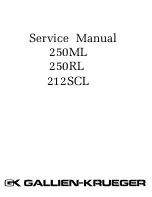
9
Mackie Industrial White Paper
Noise Sensing
September 2000
3.4 Additional Main Screen Options
The main screen of the SP-Control™ also provides the ability
to save and recall 10 presets. These presets are stored in the
EEPROM onboard the SP-DSP1™ (see Figure 3). A preset
consists of the following parameters:
Minimum Gain
,
Gain
Range
,
Noise Threshold
,
Noise Range
,
Attack
and
Release
Times
. There are two Global parameters that are recalled at
power up and displayed when
Connect
is selected on the main
screen. These include the
Bypass
state and the
CAL
or calibra-
tion value. Additionally, the preset that was saved or recalled
when the SP-Control™ was last connected will be stored in
the EEPROM and recalled at power up. The
CAL
value is set
during
Auto Calibration
and will be discussed in the next sec-
tion. The
Bypass
toggle, as its name implies, allows the user
to bypass program input to program output and effectively
disables the algorithm. This is a useful feature during setup
to ensure the proper levels are obtained. Finally, the
DSP1/2
toggle allows the user to change between communicating with
DSP1 or DSP2. As you are already aware, the SP2400/1200
can support two SP-DSP1™ cards; one for each zone. There-
fore, if your system has two controllers, this toggle allows you
to control each card separately and independently.
3.5 Auto Calibration
The Drop Menu of the SP-Control™ has several functions
shown in Figure 4. The
Auto Calibration
provides the user
with the ability to automatically adapt his speaker-microphone
placement to the room acoustics (patent pending). This func-
tion eliminates the tedious calibration procedures associated
with other competitor’s products. Additionally, the possibility
of “runaway” system gain is greatly reduced because the algo-
rithm (a modied nLMS adaptive lter) is constantly making
“running” changes to obtain the best noise-to-signal ratio.
To maximize the results, an
Auto Calibration
should be per-
formed while the room noise is at a minimum. However, since
the algorithm adapts over time, this is not a critical require-
ment. Once the speaker(s) and ambient microphone are in
their xed locations and the microphone gain and input levels
have been adjusted (per Section 3.3 Bar Graphs/Metering),
simply select
Auto Calibration
while playing standard pro-
gram material. Prior to performing the
Auto Calibration
,
please ensure that the front panel level control on the
SP2400/1200 is set to the maximum sound level that you
would ever expect the system to deliver. Recall that the noise
sensor only attenuates the signal from input to output. During
the calibration, a count-down timer is initiated at 90 seconds
and a progress meter is displayed. If the algorithm nds that
adaptation improvements are possible, the timer is reset to
90 seconds. A typical calibration period is 2-3 minutes. It is
advised to monitor the main four meter levels during calibra-
tion to ensure that all levels are in their target range as
suggested in Section 3.3 Bar Graphs/Metering. If you nd that
the microphone and input levels are too low or too high, you
may want to
Abort
the calibration by selecting the appropriate
button and then readjust the levels accordingly. There is also
an
End & Save
button if the user nds that calibration is
taking too long or music breaks are causing count-down timer
resets. Typically, music breaks between songs are no problem.
However, if the break is too long, the calibration may be
ineffective resulting in numerous timer resets. If this becomes
a problem, simply changing to different program material
or using music with shorter pauses between songs should cor-
rect the situation. Once the calibration is complete, the
CAL
value will update. At default, this value is +10 (range: +20
to –80dBr). This number is a measure of how much of the
program material is getting rejected in the environment that
the
Auto Calibration
was performed. The closer the number
is to +10, the less rejection. A
CAL
= -15dBr would be an
excellent rejection and would be expected in a small room.
However, in larger rooms and auditoriums, the rejection will
be less (closer to 0dBr). Remember that this number is only
an estimate of rejection that is used by the algorithm to set the
Noise Threshold Override.
Figure 4: SP-Control™ Function






























